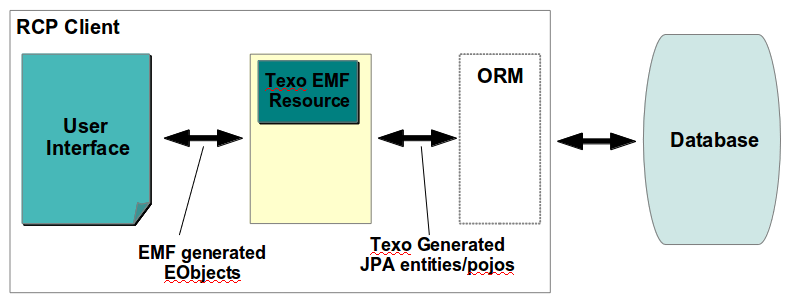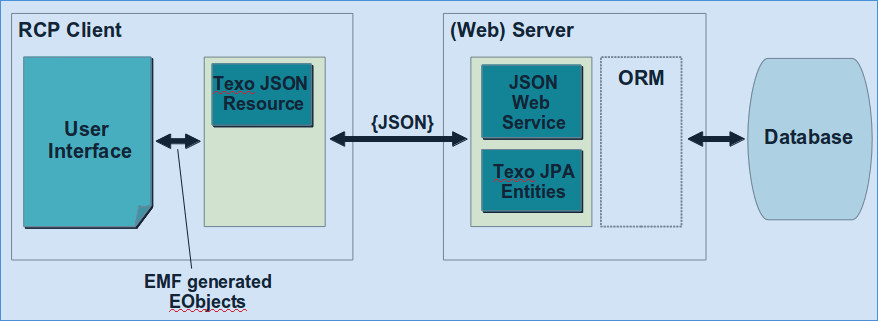Notice: this Wiki will be going read only early in 2024 and edits will no longer be possible. Please see: https://gitlab.eclipse.org/eclipsefdn/helpdesk/-/wikis/Wiki-shutdown-plan for the plan.
Texo/EMFResource
Contents
Introduction
Texo also supports you in when developing a RCP solution. The solution architecture has 2 parts:
- an EMF generated user interface which uses EObjects
- a Texo generated persistence layer, using standard JPA/ORM
To support this architecture Texo has implemented a new resource: the TexoResource. This implementation has 2 subclasses implementing different scenarios:
- EPersistenceTexoResource: for direct integration in the same systems layer with the ORM, the 2-tier architecture.
- JSONTexoResource (under development): this resource allows you to implement a 3-tier architecture.
Architecture
2-Tier Architecture
Currently (build 9th May 2012) a 2-tier architecture is supported through the EPersistenceTexoResource which is located in the org.eclipse.emf.texo.server plugin. This resource implementation makes use of the Texo EntityManager integration to have access to an EntityManager to retrieve and read information.
In this 2-tier architecture the EMF Resource talks directly (through Texo) with the ORM layer and the database.
3-Tier Architecture
In the near future also a 3-tier architecture will be supported. A new type of EMF resource: TexoJSONResource is being implemented (May 2012) which allows you to have a 3 tier architecture:
- front-end: the user interface - client using standard EMF generated code
- middle-tier: the web server layer provides a CRUD JSON web service function and the JPA/ORM persistence
- database
Using the Texo Resource
The EPersistenceTexoResource uses the Texo EntityManager integration to have access to an EntityManager, please check out the Texo EntityManager wiki page for more information.
Information can be loaded in the Texo resource in 2 ways:
- by setting the types URI parameter in the URI of the resource, the types parameter should be a comma delimited list of JPA entity names, normally the EClass name is used. For example: http:/localhost:8080/texo?types=Library,Book
- by directly calling the query method on the TexoResource, the query method allows free format HQL/JPQL queries with named parameters.
Persisting your changes can be done by calling the save method (the one without the outputstream parameter) on the resource. Updates, new objects and deletions are persisted.


